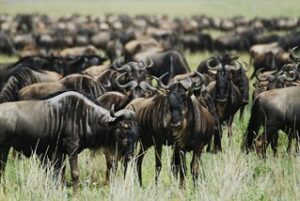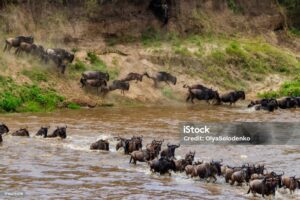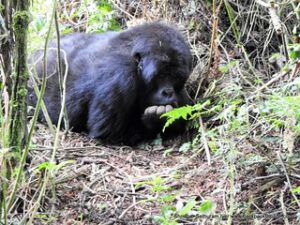An exciting adventure, an African safari provides a chance to see some of the most amazing species on Earth in their natural environment. The particular nation, the species you want to view, and the kind of safari experience you are looking for will all affect the optimum time to travel on an African safari. The best periods for a safari in numerous important areas of Africa. It includes East Africa (Kenya and Tanzania), Southern Africa (South Africa, Botswana, and Zimbabwe), and other well-known safari locations—are investigated in this essay to guide you further, it also takes into account elements such climate, animal behavior, and visitor seasonality.
East Africa: Tanzania and Kenya – African safari
Renowned for the Great Migration, one of the most amazing animal shows on Earth, East Africa—especially Kenya and Tanzania are the optimal time to visit these nations depends in great part on the timing of the Great Migration.
The Great Trek – African safari
Over two million wildebeest, zebras, and gazelles migrate in a circular path between the Serengeti in Tanzania and the Masai Mara in Kenya. Driven by the search for new water and grazing, this event has a quite predictable course:
December to March
Thousands of calves are born by the Serengeti herds in Tanzania. Predators like lions, cheetahs, and hyenas are also quite active and take use of the plenty of prey, hence this is a perfect time to visit. Usually warm and dry, the weather is perfect for game viewing.
April to June – African safari
The herds start headed north toward the Masai Mara. The lengthy rains of this time make certain places challenging to get around. Still, the terrain is verdant and green, and there are few visitors, thereby providing a more private safari experience.
July to October
Because of crocodiles, the herds cross the Grumeti and Mara rivers—a dangerous trip. Arguably, this is the most dramatic aspect of the migration and a peak travel season. It’s easy to find animals since the weather is dry and the creatures gathers near water sources.
November finds the herds beginning their return trip to the Serengeti. With few visitors, this is a great time to visit as the landscape starts to green once more during a brief wet season.
Views of General Wildlife – African safari
Apart from the Great migration, East Africa gives outstanding year-round views of wildlife. Generally speaking, though, the ideal times to visit are the dry seasons—June through October and December through March. Water is limited during these times; hence animals concentrate around rivers and waterholes to be more easily found.
Southern Africa; Botswana, Zimbabwe, and South Africa
From the rich wetlands of the Okavango Delta to the scorching Kalahari Desert, Southern Africa presents a range of safari experiences.
South Africa
Among the most well-liked safari locations worldwide is South Africa’s Kruger National Park Visit Kruger best during the dry season, which runs May through September. The vegetation is limited during these months, and animals gather near water sources, which helps to forecast game watching. Additionally, more moderate are the temperatures, which would make visiting comfortable.
Although the wet season (October to April) delivers rich scenery and young animals, the dense undergrowth makes spotting of wildlife more difficult. But as migratory species come, this time is perfect for birdwatching.
Botswana
Botswana is well known for its luxury safaris and immaculate landscapes. The best moment to visit Botswana mostly depends on the particular area:
The Okavango Delta’s peak season falls in the dry, June through October. During this period the delta floods, producing a distinctive water-based safari experience with boat and mokoro (dugout canoe) rides. Concentrated on the islands, wildlife offers first-rate viewing chances.
The best time to explore Chobe National Park—known for its enormous elephant populations—is during the dry season, May through October. The Chobe River turns into a vital water supply drawing a range of species.
Although the green season (November to April) offers rich scenery and a lot of birdlife, the availability of water causes more dispersion of the animals.
Egypt – African safari
Two top safari spots in Zimbabwe are Mana Pools National Park and Hwange National Park. Visit Zimbabwe best during the dry season, which runs from May to October. Given animals gather near waterholes, wildlife is more easily visible. The risk of malaria is less and the temperatures are milder.
The wet season, which runs November to April, turns the scene into a lush paradise and is a great time for birdwatching and seeing young animals. Still, certain places could be difficult to reach because of the plenty of rain.
Additional Notable Safari Travel Sites
Namibia
With its spectacular desert settings and unusual species, Namibia presents a different safari experience. Etosha National Park is best visited during the dry season, June to October, when animals gather around the few surviving waterholes.
The rainy season, which runs November to April, brings migratory bird arrival and a change of the terrain. Although animals can be more scattered, the landscape is breathtaking, and visitor count is smaller.
Rwanda’s and Uganda’s – African safari
Mountain gorilla trekking is well-known from Uganda and Rwanda. Gorilla trekking is best done in the dry seasons—that is, June through September and December through February. Less muddy forest trails during these times simplify trekking.
But gorilla trekking happens year-round, and the wet seasons—March through May and October through November—often provide less visitors and a more personal encounter with the gorillas.
Elements Affecting the Best Time for a Safari
The optimal time for an African safari should be determined considering several elements:
Environment and Weather – African safari
Safari experiences are strongly influenced by the temperature and conditions. Viewing wildlife is usually best during the dry seasons when animals gather around water sources. Still, the wet seasons provide rich scenery, less visitors, and chances to witness migrating birds and baby animals.
Nature’s Behavior
A safari’s planning depends on an awareness of animal behavior. Seasonal occurrences like the Great Migration in East Africa and the flooding of the Okavango Delta in Botswana affect the ideal times to travel.
Travel seasons
The ideal times for watching animals’ line high tourist seasons (June through October and December through March). These days, though, they can be more costly and packed. The shoulder seasons (April to May and November) provide a mix of reduced visitors and decent animal watching.
Individual Choices
The optimal timing for a safari is highly influenced by personal tastes. While some visitors would value the consistency of wildlife encounters during the dry season, others could enjoy the rich scenery during the wet season.
Ultimately
Ultimately, the best time to go on an African safari will rely on your personal tastes, the particular nation, and the animals you hope to view. Because animals gather around water sources, the dry seasons—June through October and December through March—offer often the best chances for wildlife watching. The wet seasons, April through May and November, offer rich scenery, less visitors, and chances to view migrating birds and young animals, though.





